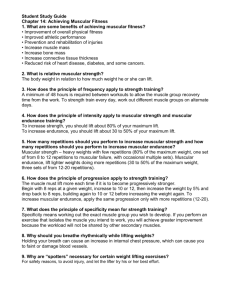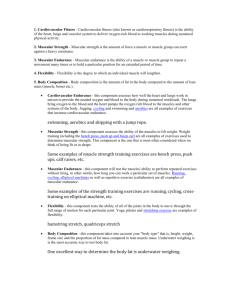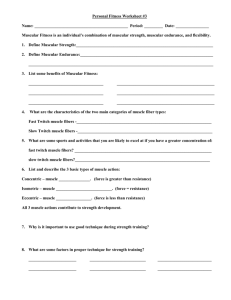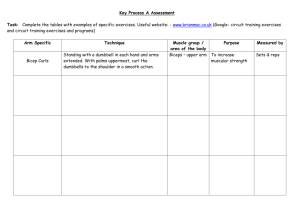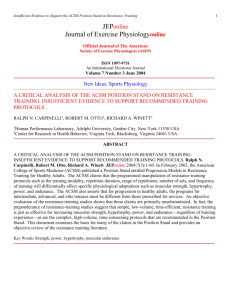Student Study Guide Chapter 14: Achieving Muscular Fitness 1
advertisement
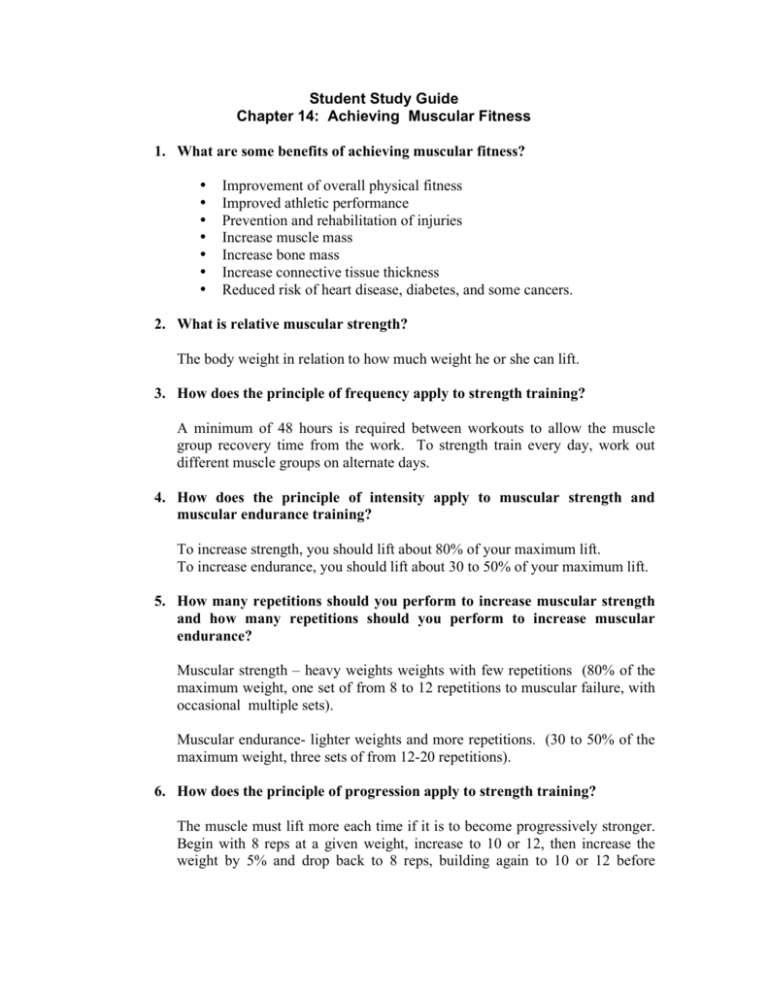
Student Study Guide Chapter 14: Achieving Muscular Fitness 1. What are some benefits of achieving muscular fitness? • • • • • • • Improvement of overall physical fitness Improved athletic performance Prevention and rehabilitation of injuries Increase muscle mass Increase bone mass Increase connective tissue thickness Reduced risk of heart disease, diabetes, and some cancers. 2. What is relative muscular strength? The body weight in relation to how much weight he or she can lift. 3. How does the principle of frequency apply to strength training? A minimum of 48 hours is required between workouts to allow the muscle group recovery time from the work. To strength train every day, work out different muscle groups on alternate days. 4. How does the principle of intensity apply to muscular strength and muscular endurance training? To increase strength, you should lift about 80% of your maximum lift. To increase endurance, you should lift about 30 to 50% of your maximum lift. 5. How many repetitions should you perform to increase muscular strength and how many repetitions should you perform to increase muscular endurance? Muscular strength – heavy weights weights with few repetitions (80% of the maximum weight, one set of from 8 to 12 repetitions to muscular failure, with occasional multiple sets). Muscular endurance- lighter weights and more repetitions. (30 to 50% of the maximum weight, three sets of from 12-20 repetitions). 6. How does the principle of progression apply to strength training? The muscle must lift more each time if it is to become progressively stronger. Begin with 8 reps at a given weight, increase to 10 or 12, then increase the weight by 5% and drop back to 8 reps, building again to 10 or 12 before increasing the weight again. To increase muscular endurance, apply the same progression only with more repetitions (12-20). 7. What does the principle of specificity mean for strength training? Specificity means working out the exact muscle group you wish to develop. If you perform an exercise that isolates the muscle you intend to work, you will achieve greater improvement because the workload will not be shared by other secondary muscles. 8. Why should you breathe rhythmically while lifting weights? Holding your breath can cause an increase in internal chest pressure, which can cause you to faint or damage blood vessels. 9. Why are “spotters” necessary for certain weight lifting exercises? For safety reasons, to avoid injury, and let the lifter try his or her best effort. 10. What are safety precautions that the spotter should be able to perform? • • • • • • • Know how the exercise should be performed. Help improve form when necessary. Be physically able to assist with the weight. Use correct lifting techniques. Communicate with the lifter, assist when necessary. Know signals for starting and finishing the lift. Check to make sure weight plates and collars are secure throughout the lift. 11. List the advantages and disadvantages of isometric exercises. Advantages: They can be performed almost anywhere without elaborate and expensive equipment. Disadvantages: Muscular endurance, cardiorespiratory fitness, and flexibility are not improved. Muscles are not moved through the full range of motion. The accompanying rise in blood pressure may be harmful for some people. 12. How does isotonic training help increase strength? Isotonic training helps the muscle get stronger through the entire range of motion of the joint. However, the tension varies at different points in the muscle movement. 13. What are the benefits of isokinetic exercises? In isometric exercises, muscle tension is kept at maximum throughout the full range of muscle movement. Some machines control the velocity of the movement and match the amount of resistance to the effort put forth by the individual. 14. What is circuit training? What are safety precautions which should be followed while circuit training? Six to 20 exercise stations. The weight trainer performs an exercise and then quickly moves to the next station performing a certain number of repetitions or doing as many reps as possible during a time period (from 20-60 seconds) at each station. Be certain all exercises are performed correctly. Make certain seat and weight adjustments are made and belts fastened (if any). Warm up thoroughly before beginning the circuit.

